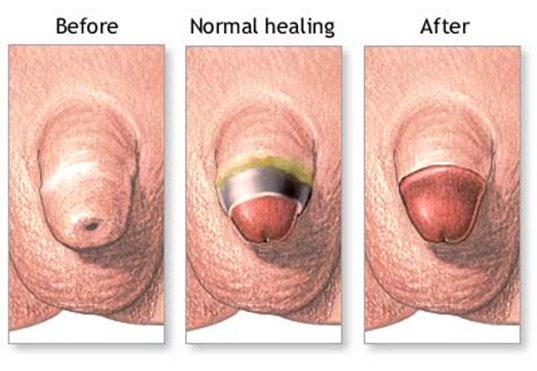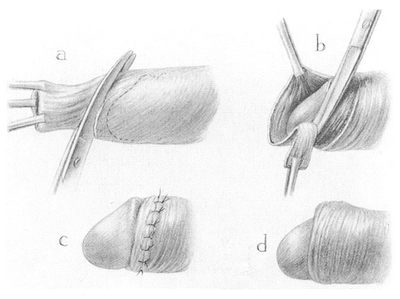 Circumcision refers to the surgical removal of the foreskin that covers the glans or head of the penis. Every boy is born with this foreskin, which is surgically removed during circumcision to expose the glans. The procedure on adult patients is different from that of infant because it requires a higher level of skill and precision. This article discusses circumcision before and after issues to inform readers on how and when the surgery is performed, along with proper after-care for circumcision patients.
Circumcision refers to the surgical removal of the foreskin that covers the glans or head of the penis. Every boy is born with this foreskin, which is surgically removed during circumcision to expose the glans. The procedure on adult patients is different from that of infant because it requires a higher level of skill and precision. This article discusses circumcision before and after issues to inform readers on how and when the surgery is performed, along with proper after-care for circumcision patients.
When Is Circumcision Performed?
This surgical procedure is mostly performed two to three weeks after birth. However, circumcision is also performed on an adult.
 Circumcision can be performed on an infant immediately after birth depending on its health status. If the baby is born healthy, circumcision can be performed before leaving the hospital or immediately after. Yet, when the baby is born with medical complications, circumcision can be performed after the baby recovers. Circumcision is also performed on adults or older children. Such patients are at a higher risk of complications than infants and may take longer to heal.
Circumcision can be performed on an infant immediately after birth depending on its health status. If the baby is born healthy, circumcision can be performed before leaving the hospital or immediately after. Yet, when the baby is born with medical complications, circumcision can be performed after the baby recovers. Circumcision is also performed on adults or older children. Such patients are at a higher risk of complications than infants and may take longer to heal.
A surgical procedure is conducted to remove the foreskin from the head of the penis. After the surgery, the penis has no excess foreskin and may heal in about five to seven days. This procedure takes about 10 minutes for newborns and about an hour for adult patients.
Circumcision Before and After, What Difference Would It Make?
 The knowledge of circumcision before and after the procedure is important to parents of newborns and adult patients, because it reveals the benefits of circumcision and preparations for the recovery process.
The knowledge of circumcision before and after the procedure is important to parents of newborns and adult patients, because it reveals the benefits of circumcision and preparations for the recovery process.
The procedure decreases the risk of contracting urinary tract infections. Circumcised males are at a lower risk of sexually transmitted diseases than uncircumcised males. Another benefit of circumcision is that, it can prevent from penile cancer and also reduces the risk of cervical cancer in the male's sex partner.
Removing the excess foreskin prevents inflammation of the glans or foreskin. The inflammation of the glans is called balanitis, and inflammation of both the foreskin and glans is referred to as balanoposthitis. Circumcision prevents phimosis, which is the inability to retract the foreskin. In addition, the procedure prevents paraphimosis, which refers to the inability to restore the penile foreskin to its original location. Another benefit of circumcision is that it makes it easier to keep the head of the penis clean.
Understanding circumcision before and after can help eliminate misconceptions and myths about the procedure. One misconception about circumcision, especially cosmetic circumcision, is that it changes the size of the penis. Cosmetic circumcision does not increase or reduce the size of the penis. Instead, it enhances the appearance of the penis and makes it easier to clean.A cosmetic circumcision procedure maybe performed to correct or improve the appearance of a penis from previous circumcision procedures. The penis will be more attractive during erections but will not change in size.
Possible complications after a circumcision procedure can include bleeding, penile infections and scarring. Also in quite rare cases, a surgery may fail to remove all excess foreskin or remove too much of it. Such patients require another surgical procedure to correct this outcome.
Circumcision After-Care for Infants and Adults
A clear understanding of circumcision before and after prepares caregivers to help circumcision patients in their recovery process. The after-care for infants and adultsis different, read to find the right after-care options.
For Infants
When the foreskin is removed during circumcision, it leaves an open wound at the end of penis. This open wound is at a risk of infections and hence every circumcision procedure must be done in sterile conditions. The doctor's hands should be clean and in gloves during the procedure. The doctor should use sterile instruments to remove the foreskin. Before the procedure, the foreskin should be cleaned thoroughly with an antiseptic solution. The gauze pad used to stop bleeding and the wound dressing should be sterile.
Parents should take care of the wound after circumcision until it heals fully. Infections should be prevented by dressing the wound with fresh gauze pads when changing the baby's diaper. They may apply petroleum jelly or any other ointment on the gauze pad before dressing the wound. Parents and caregivers must wash their hands thoroughly with water and soap before and after dressing the wound.
For Adults
Doctors use dissolvable sutures and bandages to dress the circumcision wound. The patient's underwear should hold this bandage in place to avoid movements. Doctors will always give instructions to adult patients on when and how to remove the bandage. Such instructions must be followed. The bandage should not be removed before the recommended time. Adult patients are advised to wait until the wound heals fully before resuming sexual activities. The recovery process may be one or two weeks. Sometimes hospitals offer to take care for circumcision patients until they recover fully. Patients should take advantage of this after-care and honor their appointments.
